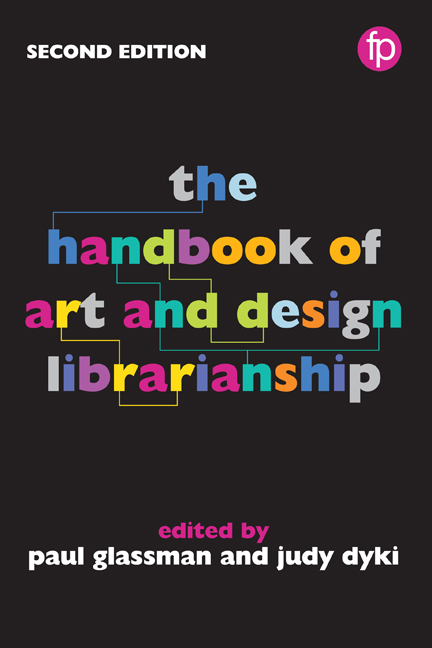Book contents
- Frontmatter
- Contents
- List of figures and tables
- Notes on contributors
- Foreword
- Preface
- Part I Roles and responsibilities
- Part II Materials and collection management
- 6 Visual resources: from analogue to digital and beyond
- 7 Developing digital collections
- 8 Inspirational encounters: the management and use of archives and special collections in the art and design library
- 9 What is special about special collections?
- 10 Artists’ books in the art and design library
- 11 Art documentation: exhibition catalogues and beyond
- 12 Tactile libraries: material collections in art, architecture and design
- 13 Seeing the bigger picture: archival description of visual information
- Part III Teaching and learning
- Part IV Knowledge creation
- Part V The physical environment
- Part VI Promotion and sustainability
- Appendix Library profiles
- Index
13 - Seeing the bigger picture: archival description of visual information
from Part II - Materials and collection management
Published online by Cambridge University Press: 08 June 2018
- Frontmatter
- Contents
- List of figures and tables
- Notes on contributors
- Foreword
- Preface
- Part I Roles and responsibilities
- Part II Materials and collection management
- 6 Visual resources: from analogue to digital and beyond
- 7 Developing digital collections
- 8 Inspirational encounters: the management and use of archives and special collections in the art and design library
- 9 What is special about special collections?
- 10 Artists’ books in the art and design library
- 11 Art documentation: exhibition catalogues and beyond
- 12 Tactile libraries: material collections in art, architecture and design
- 13 Seeing the bigger picture: archival description of visual information
- Part III Teaching and learning
- Part IV Knowledge creation
- Part V The physical environment
- Part VI Promotion and sustainability
- Appendix Library profiles
- Index
Summary
Introduction
One of the most persistent challenges special collections librarians face is how to explain what they do. Casual conversations with strangers – to prevent them from becoming protracted – require omission of the word ‘archivist’ and the negative definition, ‘It's the stuff you can't check out of the library.’ This is an oversimplification, of course, but in truth there are not many other commonalities with other occupations to point to when describing archives and special collections. Given the potentially infinite range of collection formats and topics, absolute definitions are elusive. The answer to every archival question accommodates ambiguity and may often be ‘it depends’. It is much easier to explain the few tangible qualities, like rules and restrictions, or to characterize special collections by how they differ from ‘regular’ collections.
This might seem like a rather abstract conundrum, but it becomes very concrete when the job is to describe these materials. Description is an essential library service of which readers may be unaware. The catalogue reveals where the desired item is; the item is retrieved. That seems easy. But the description of materials in special collections is often more complex, and sometimes even the fundamental nomenclature indicating what an item is can be difficult to identify. In a closed-stack environment, the stakes are higher since browsing is precluded, making accurate and detailed description is essential. There are few shortcuts for patrons that bring intellectual serendipity, like determining where an author's work or subject is shelved and then going there to see which book is the one they want. (With the word ‘see’ we have the linguistic bias toward visuality, the ocularcentric conflation of ‘seeing’ and ‘knowing’ [Rose, 2012, Chapter 1.1]). Users might not be aware that manu - scripts and unique materials even exist, much less how to look for them in a catalogue search. Thus for cataloguers of special collections, the task is not simply to make known items findable, but rather to describe the uncommon qualities of unknown items to an audience that cannot see them in a way that makes them not only retrievable, but also desirable.
- Type
- Chapter
- Information
- The Handbook of Art and Design Librarianship , pp. 129 - 136Publisher: FacetPrint publication year: 2017
- 1
- Cited by

